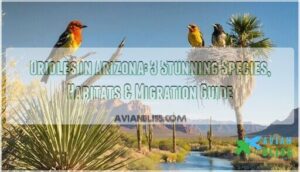This site is supported by our readers. We may earn a commission, at no cost to you, if you purchase through links.

Bullock’s orioles flash their fiery orange plumage through cottonwoods along rivers, while hooded orioles make themselves at home in your neighborhood palm trees, weaving hanging nests like nature’s own basket weavers.
Scott’s orioles break the mold entirely—they’re the desert rebels, thriving in yucca-dotted mountainsides year-round.
These aren’t your typical woodland birds; Arizona’s orioles have cracked the code on desert living, transforming from seasonal visitors into permanent residents.
Each species brings unique feeding habits, nesting preferences, and migration patterns that reveal surprising secrets about surviving in the Southwest’s challenging environment.
Table Of Contents
Key Takeaways
- You’ll find three distinct oriole species in Arizona: Bullock’s orioles with fiery orange plumage in riverside areas, hooded orioles weaving nests in suburban palm trees, and Scott’s orioles thriving year-round in desert mountains with their striking black and yellow coloration.
- You can attract these colorful birds to your backyard by offering fresh orange halves, grape jelly, sugar water, and nectar feeders, especially during their most active feeding times in early morning and evening hours.
- You’ll spot orioles most easily during Arizona’s breeding season from March through August, when males display their most vibrant plumage for mating displays and their distinctive songs help distinguish between species.
- You’re witnessing remarkable desert adaptation as these birds have cracked the code on surviving Arizona’s harsh environment by utilizing urban areas, riparian corridors, and native desert plants while some populations stay year-round instead of migrating.
Arizona Oriole Species
You’ll encounter three distinct oriole species during Arizona’s breeding season from March through August.
These colorful birds include Bullock’s Oriole with its bright orange and black plumage, the yellow Hooded Oriole with its distinctive black face mask, and Scott’s Oriole featuring striking black and yellow coloration.
Bullock’s Oriole
You’ll spot the brilliant Bullock’s Oriole (Icterus bullockii) across Arizona’s desert woodland from March through August.
Arizona’s desert woodlands come alive with the brilliant flash of Bullock’s Orioles during breeding season.
Males flash striking orange and black plumage while females display subtle grayish-yellow tones.
These skilled weavers create pendulous nests using plant fibers, expanding their range into urban areas where nectar feeders supplement their insect-heavy diet.
- Male Markings: Flaming orange body with bold black wings featuring distinctive white patches
- Juvenile Plumage: Grayish-yellow coloration with orange highlights on face and chest areas
- Nest Construction: Expertly woven hanging baskets crafted from grass and plant fibers
Hooded Oriole
You’ll recognize the Hooded Oriole by its striking yellow plumage and distinctive black mask across its face.
This desert woodland species shows a clear palm preference for nesting, weaving nest fibers from palm fronds.
They’re common in Arizona’s suburban habitats, frequently visiting nectar feeders alongside hummingbirds, making bird identification easier for backyard enthusiasts.
The similar Audubon’s Oriole exhibits distinctive foliage gleaning foraging behavior.
| Feature | Male | Female |
|---|---|---|
| Body Color | Bright yellow belly/neck | Olive-yellow overall |
| Head Marking | Black mask and throat | Faint grayish markings |
| Wings | Black with white bars | Grayish-brown |
| Size | 7-8 inches | 7-8 inches |
| Bill Shape | Slightly curved, pointed | Slightly curved, pointed |
Scott’s Oriole
Scott’s Oriole stands out among Arizona bird species with its striking black and yellow plumage.
You’ll find this member of the Icterus genus in high desert regions, where it builds nests using yucca plants as both shelter and nesting materials.
Scott’s song echoes through the Sonoran Desert as these orioles maintain a varied oriole diet of insects and nectar.
Oriole Physical Characteristics
You’ll easily recognize Arizona’s orioles by their distinctive features and striking color patterns that vary between males and females.
These slender birds display sharp, pointed bills perfect for catching insects and long tails that help with balance during their acrobatic feeding sessions.
Male Plumage
You’ll be amazed by the spectacular Color Patterns displayed by male orioles in Arizona. These birds showcase brilliant Vibrant Hues that make them impossible to miss during breeding season. Their Bright Feathers serve as powerful tools for Mating Displays, helping attract potential mates through stunning visual presentations.
Here are five key features of Male Plumage in Arizona orioles:
- Bullock’s Oriole males – Display flaming orange bodies with jet-black wings featuring distinctive white patches
- Hooded Oriole males – Show bright yellow bellies contrasting sharply with black throats and wing markings
- Scott’s Oriole males – Feature striking yellow undersides paired with completely black heads and backs
- Seasonal intensity – Plumage Variations become most vibrant during spring breeding months in Arizona
- Species identification – Each male’s unique bird plumage patterns help distinguish between the three Arizona bird coloration types
Understanding bird identification techniques is essential for recognizing these distinct species.
These remarkable Orioles transform Arizona’s landscape with their dazzling displays, making male identification straightforward for birdwatchers across the state.
Female Coloration
While males show off with vibrant colors, female orioles display more subdued beauty.
You’ll notice their muted hues of olive-green, grayish-yellow, and pale orange tones.
These dull feathers aren’t accidents – they’re evolutionary advantages.
Female plumage provides perfect camouflage while nesting, protecting both mother and eggs.
Arizona bird coloration differences between sexes help female orioles stay hidden from predators.
Beak and Tail Features
You’ll notice Arizona orioles sport sharp, slightly curved beaks perfect for piercing fruit and catching insects.
Their bills typically display dark coloration with subtle variations between species.
These birds feature remarkably long tails that help with balance during acrobatic feeding maneuvers.
The tail feathers create elegant silhouettes as orioles navigate through desert vegetation, making beak shape and tail length key identifying characteristics.
Oriole Habitat and Distribution
You’ll find Arizona’s orioles across three main habitat types that provide the resources they need for survival.
These colorful birds inhabit desert regions near water sources, lush riparian areas along rivers and streams, and urban environments including parks and residential neighborhoods, which can be considered as urban environments.
Desert Habitats
Arizona’s desert habitats showcase remarkable adaptability where orioles thrive against harsh odds.
These resilient birds navigate both Sonoran Desert and Mojave landscape environments, finding sanctuary near precious water sources while foraging among native desert plants that sustain arid ecosystems.
The presence of orioles is often indicated by their preference for desert bird habitats.
Here’s where you’ll spot orioles in Arizona’s desert habitats:
- Palm oases – Desert cities with planted palms create perfect nesting opportunities
- Native vegetation clusters – Mesquite and palo verde trees provide essential shelter
- Desert washes – Seasonal water sources attract insects and support diverse bird species
- Cacti forests – Saguaro and cholla offer unique perching and nesting sites
Riparian Areas
You’ll find Arizona’s orioles thriving along riparian areas where water sources create lush oases in the desert.
These wetland habitats offer abundant insects, riparian plants for nesting materials, and reliable water.
River ecosystems support all three species during breeding season, providing essential nesting sites in cottonwoods and willows that desert habitats simply can’t match.
The presence of bird feeding stations can also enhance the attractiveness of these areas to orioles, making them more desirable breeding season locations.
Urban and Suburban Areas
You’ll spot orioles thriving in city parks and suburban gardens throughout Arizona’s urban landscapes.
These adaptable birds have embraced residential trees as prime nesting sites, while backyard feeders provide reliable food sources.
Urban nesting occurs frequently in mature neighborhood trees, making your local park or garden a potential oriole hotspot during breeding season.
The presence of orioles in urban areas can be influenced by bird research findings that highlight the impact of urbanization on bird populations, which is a key factor in their breeding season.
Migration and Conservation
You’ll witness these colorful birds make incredible journeys twice yearly, traveling thousands of miles between their Arizona breeding grounds and Central American wintering areas.
Understanding their migration patterns and current conservation challenges helps you support these remarkable species as they face habitat loss and climate change threats.
Spring and Fall Migration
Epic journeys define these vibrant songbirds’ lives as they follow ancient flight routes spanning thousands of miles.
These desert wanderers transform thousands of miles into breathtaking adventures, painting the skies with their ancient journeys.
You’ll witness spring migration from March through May when orioles in Arizona arrive from Central America, using riparian areas as essential stopover points.
Fall migration begins in August, with flocking behavior intensifying as seasonal movements guide them back to wintering grounds through established migration patterns.
Understanding the Oriole Migration is vital for conservation efforts and appreciating these birds’ remarkable travels and their use of ancient flight routes.
Overwintering in Arizona
Some orioles break tradition by staying put during Arizona’s mild winters.
Climate adaptation allows these resourceful birds to thrive year-round in desert habitats.
You’ll find overwintering orioles adjusting their survival strategies through:
- Shifting to nectar and fruit-based food sources
- Selecting urban parks and suburban winter habitats
- Modifying flocking behavior patterns
- Adapting to Arizona bird habitats
- Utilizing bird migration patterns flexibility
These birds are able to make these adjustments due to their resourceful nature and ability to adapt to new environments, allowing them to survive in a variety of conditions.
Threats to Oriole Populations
While some orioles stay year-round, these beautiful birds face serious challenges.
Habitat loss from urban development destroys nesting sites, while climate change shifts their food sources and migration timing.
Pollution effects reduce insect prey, and human disturbance interrupts breeding cycles.
Fragmentation impact isolates populations, making brood parasitism and predation more common.
Bird conservation efforts now focus on protecting remaining habitats, and understanding the current bird conservation status is essential for developing effective protection strategies to address the issue of habitat loss.
Frequently Asked Questions (FAQs)
What foods attract orioles to backyard feeders?
Like bees to honey, these vibrant birds can’t resist sweet treats at your feeder.
You’ll attract them with fresh orange halves, grape jelly, sugar water, and nectar feeders that mimic their natural diet.
When is the best time to spot orioles?
Early morning hours from dawn to 10 AM offer your best chances during Arizona’s breeding season from March through August. You’ll also catch them during evening feeding times before sunset.
How can I identify oriole calls and songs?
Listen for distinct melodies during dawn and dusk when orioles are most vocal.
Bullock’s produces chattering notes, Hooded gives flute-like whistles, and Scott’s delivers clear warbling songs.
Use birding apps to compare recordings with live sounds you hear.
Do orioles return to the same nesting locations?
Generally, you won’t see orioles returning to identical nest sites.
They’ll often choose nearby trees or similar habitat areas within their territory, but they construct fresh nests each breeding season rather than reusing old ones, which can be considered a complete concept of their nesting behavior, highlighting their preference for fresh nests.
What plants should I grow to attract orioles?
Creating an oriole oasis starts with native plants that bloom and fruit during their breeding season.
Plant desert willow, palo verde, and ocotillo for nectar sources, plus mulberry and elderberry trees for insects and berries they crave.
Conclusion
Despite theories that desert environments can’t support diverse bird populations, orioles in Arizona prove otherwise through remarkable adaptations.
You’ll discover these three species transform challenging landscapes into thriving habitats year-round.
Bullock’s orioles dominate riparian corridors, hooded orioles flourish in urban palm groves, and Scott’s orioles master mountainous desert terrain.
Understanding their unique migration patterns, feeding behaviors, and nesting preferences helps you appreciate how these vibrant birds successfully navigate Arizona’s extreme conditions while maintaining healthy populations.
- https://tucsonbirds.org/wp-content/uploads/2022/03/VF-Spring-2021.pdf?ref=tas
- https://wildexplained.com/animal-encyclopedia/the-beautiful-hooded-oriole-a-guide-to-identification-and-habitat/
- https://animals.net/oriole/
- https://www.ocf.org/newsletter/orioles
- https://birdsoftheworld.org/bow/species/balori/cur/introduction?printable










